*Editor’s note: K-Odyssey introduces travel journals by alumni of Yonhap News Agency Travel Academy, provided in Korean and English. The original Korean article precedes the English translation.
*편집자 주: K-Odyssey는 연합뉴스 <여행자학교> 수료생들의 여행기를 한국어와 영어로 소개합니다. 한국어 원문을 먼저 게재한 뒤 외국 독자들을 위해 영어 번역본도 함께 싣습니다.
물은 넘쳐야 흐르고, 흘러야 깨끗해진다
신재천 (여행자학교 1기)
후드득 창문 때리는 빗소리에 잠이 깼다. 지난 저녁부터 내리는 장대비가 새벽까지 쉬지 않는다.
새벽 네 시! 호랑이가 활개 치는 인시(寅時)다. 거실 창문을 열어젖혔다. 풀잎을 뒤흔드는 바람과 시멘트에 떨어지는 빗소리가 서로 할퀴며 엉겨 붙는다. '쿠르르릉, 쿠르릉 쾅 쾅'. 수호랑이 두 마리가 암호랑이를 놓고 싸우듯이 천둥이 귀를 찢는다. 몇 초 지나지 않아 번갯불이 눈앞에서 번쩍했다.
'이런, 양구 두타연까지 가야 하는데….'
강원도 양구는 깊은 산만큼이나 시뻘건 아픔이 배어있는 지역이다. 내 아버지뻘 되는 군인에게는 월남 파병을 준비하는 기초훈련장으로, 삼촌뻘 되는 사람에게는 80년대 삼청교육대 장소로 눈물과 아픔이 묻힌 곳이다.
청년 장교였던 내게는 여러 날 동안 정찰 활동을 했던 곳이다. 호박돌이 넘쳐나는 계곡을 따라 오르기도 하고, 아슬아슬한 낭떠러지 능선 길을 달리기도 했다. 사흘 동안 죽도록 고생 하던 곳!
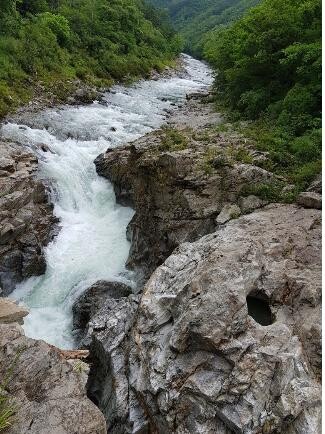 |
| ▲ 금강산에서 발원한 수입천 물줄기가 밤새 내린 비 때문에 굉음을 내며 쏟아져 내리고 있다. 두 암벽 사이 물이 보는 각도에 따라 흰 한반도 지도처럼 보인다. This photo shows the stream leading to Dutayeon that resonates the shape of the Korean peninsula. |
수려한 경관을 자랑하는 ‘두타연(頭陀淵)’은 양구군 민간인 출입통제구역(DMZ)에 있는 폭포 아래 깊고 둥글게 파인 물웅덩이다.
물이 깨끗해서 열목어 서식지로 유명하고 10미터나 되는 물줄기가 폭포를 이룬다. 높이 20미터 바위가 병풍을 두른 듯 에워싼 못(淵,沼)의 수심은 12미터나 된다.
'두타'는 번뇌의 티끌을 없애고 청정한 마음으로 불도를 수행한다는 불교 용어다.
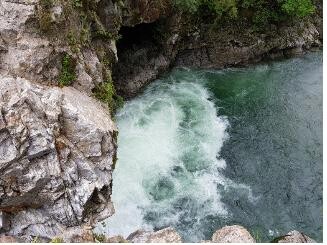 |
| ▲ 병풍처럼 둘러친 바위 틈새로 쏟아진 폭포수는 깊은 연못을 만들었다. 10여 미터 높이 암벽에서 내리 쏟으며 만들어낸 두타연. 승천하지 못한 이무기가 내리 쏟아지는 호랑이를 잡아먹는 듯 하다. This photo shows Dutayeon that falls from a 10-meter-high cliff. |
탐방길을 얼마 걷지 않아 물소리가 굉음을 낸다. 밤새도록 싸운 호랑이 때문에 골짝에는 물이 벌창하다. 새벽까지 으르렁대서 두타연 물이 호랑이 포효처럼 거칠다.
골짜기에 흐르는 물이 암벽 틈바구니에 끼어들려고 다투는 꼴이 앞발을 쳐들고 볼기를 후려치려는 두 마리 호랑이 같다. 발톱을 곤두세우고 엉겨 붙은 여러 호랑이가 서로 부둥켜안고 10미터 아래 연못으로 떨어지면 그 깊은 소(沼)에서는 또 다른 혈투가 벌어진다.
천 년 묵은 이무기와 못에 떨어진 호랑이가 콰과가강 소리를 내며 서로의 목덜미를 노리며 성을 낸다.
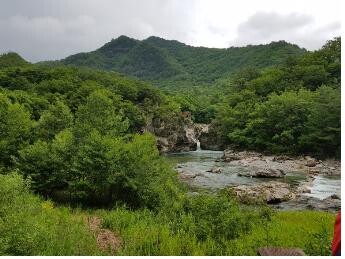 |
| ▲ 멀리서 보이는 두타연 풍경, 갈라진 바위 틈새로 쏟아지는 물줄기가 커다란 연못을 만들었다. This photo shows Dutayeon from a wider angle. |
한동안 용쟁호투(龍爭虎鬪)하는 물을 바라보았다. 번뇌와 걱정이 사라지고 호흡이 담담하게 가라앉는다. 거칠게 용솟음치고 뒤틀리는 폭포수의 귀청을 찢을 듯한 물소리에도 마음은 오히려 평온해 진다. 두타가 된 것인가?
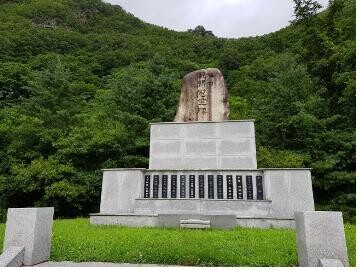 |
| ▲ 양구전투위령비, 우리 국군 이외에 미군이나 네덜란드 참전 군인들의 무수한 영령이 잠든 곳에 위령비를 세웠다. This photo shows the Yanggu War Monument. |
두타연 어귀 한적한 곳에 양구전투위령비가 있다.
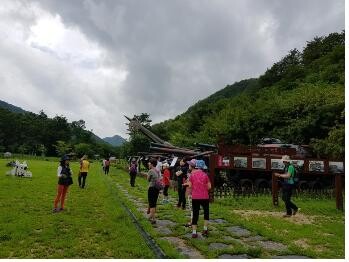 |
| ▲ 위령비 옆에는 조각공원을 만들어 6.25전쟁 때 활약했던 무기와 장비를 전시했다. 피의 능선 전투를 비롯한 양구지역 전투에 대한 상세한 안내판도 있어서 안보교육 장소로서도 좋다. This photo shows the park where weapons and equipment from the Korean War are displayed. |
양구지역 전투는 전쟁 막바지에 한 치의 땅이라도 더 차지하려는 피아간 혈투였다. 38선 탈환을 위해 투입된 중공군과 인민군에 맞서 국군과 미군은 결사적으로 싸웠다. 박격포탄과 공중 폭탄이 하루에도 수만 톤씩 쏟아지고 긴 대검을 착검한 육박 혈전이 벌어졌다.
피의 능선과 단장의 능선은 미군 종군기자가 'Bloody Ridge, Heartbreak Ridge'라고 부른 데서 유래한다. 얼마나 치열했으면 능선이 빨갛게 물들고 창자(腸)가 끊어질(斷) 정도로 격렬한 전투였겠는가?
피의 능선 전투는 영화 '태극기 휘날리며'의 배경이 됐다.
두타연 계곡 일대는 지뢰매설지역이다. 탐방길 외에는 철조망이 쳐져 있고 그 철조망에는 어김없이 지뢰를 알리는 경고판이 매달려 있다. DMZ라서 50여 년 동안 민간인 출입이 통제됐다가 몇 해 전부터 관광지로 개방됐다.
DMZ는 전 세계인이 주목하는 곳이다. 지뢰 밀집도가 가장 높고 세계 역사상 최고의 살상무기가 배치된 곳이다. 이곳을 비무장지대(De-Militarized Zone)라고 부르는 것은 황당한 난센스다.
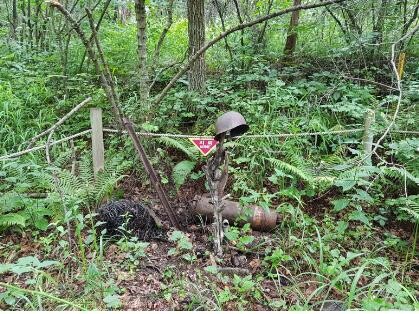 |
| ▲ 녹슨 철모. This shows the wood monument with a rusty steel helmet on top. |
탐방길 중간 쯤에 녹슨 철모가 걸린 비목이 있다. 뒤엉킨 철조망 아래 포탄피가 덩그러니 뒹굴고 철모 쓴 나무 기둥이 외롭다.
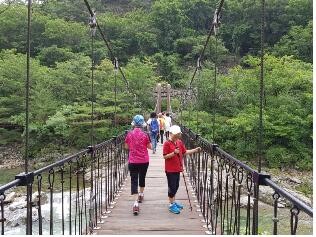 |
| ▲ 수입천을 가로지는 구름다리, 다리 아래에는 옥빛 같이 맑은 계곡물이 흐른다. This shows the bridge running across he Su-Ibcheon. |
이제 두타연에도 사람이 모여든다. 친구끼리 트레킹을 하고, 부부가 힐링하러 오고 부모와 아이들이 선글라스와 카메라를 들고 찾아온다.
물은 넘쳐야 흐르고, 흘러야 깨끗해진다.
남과 북, 어느 쪽 지류에서 더 많은 물이 들어올지 모른다. 수입천 개울물이 금강산에서 흘러내린 물과 어깨동무하고 파로호에 들어가듯이, 휴전선 너머 있는 사람들과 친구처럼, 부부처럼, 부모 자식처럼 함께 사진을 찍고 싶다.
- 두타연 방문을 위해서는 1일 전까지 인터넷 예약을 해야 한다.1시간 남짓한 탐방길이나 ‘소지섭 길’을 걸어도 좋고 인근 제4땅굴이나 을지 전망대를 가보는 것도 좋다.
Mind-cleansing waters of Dutayeon
By Jae-cheon Shin (Alumnus of Travel Academy season 1)
That morning, I woke up to the sound of rain tapping on the window. The rain, which has been pouring since last evening, was continuing to fall until dawn.
When the clock stroke 4 A.M., and when it was time for tigers to strut around, I opened up the living room windows. The sound of the wind brutally shaking the grass and the rain vibrantly hitting on cement were fighting as if they were to show off their relentlessness. Then, the thunder roared furiously, as if they were two tigers fighting over a female one.
“Oh gosh, I have to go all the way to Dutayeon in Yang-gu.” I mumbled to myself as the lightning soon flashed before my eyes, following the banging thunder in a few seconds.
Yang-gu, a county within Gangwon Province, is a place with a painful, bloody history that is as red as the steepest mountains are: It was a basic training ground where soldiers, who were as old as my father was, made themselves ready to be dispatched to Vietnam; meanwhile, for those who were as old as my uncle was, it was where they had buried their painful memories from the Samchung re-education camp during the early 1980s.
For me, it was where I, as a young officer, spent many days scouting. The district and I shared memories of climbing up a stream covered with dornicks and racing along a narrow cliff. It was also where I had one of my worst three days of my lifetime, during which I was near the end of my rope!
Dutayeon, however, also flaunts marvelous scenery. This deep, round water hole, which is right under the waterfall in the Korean demilitarized zone (DMZ) in Yang-gu, is known for its crystal-clear water. Its uncontaminated spring water has become home to countless Manchurian trout. Its 10-meter-long waterfall is enough to create an eye-watering landscape. Surrounded by a 20-meter-high rock, the pond, or “yeon,” itself is 12-meter-deep. The pond was named Duta, which originated from the Sanskrit word dhuta, meaning “shaken off.” In Buddhism, it indicates shaking off the dust and defilement of desires.
Not long after we started following the trekking course, I could hear the water roaring ahead. The valley was already flooding with rainwater that fiercely hit the ground all night like tigers growling at each other. The water running down Dutayeon was as fierce as the rain that ferociously tapped the ground last night. The water ran down the valley as if two tigers were attempting to raise their paws up high and pound on each other’s cheeks. When those tigers got clogged with each other’s paws, they then fell into a pond 10 meters below, where another bloody battle was taking place. They then all together encountered a thousand-year-old python and went after each other’s necks.
For a while, I gazed into the water, which was as ferocious as a battlefield of tigers and dragons may be. Ironically, the water had all my anguish and anxiety fade. I could then listen to my breath calming down. The earsplitting waterfall that was still thundering rather calmed my mind. I wondered if I had reached the state of “dhuta.”
In the corner of the pond, there stood the Yang-gu War Monument with plaques honoring the Capital Mechanized Infantry Division; 3rd, 5th, 7th, 8th, 20th, and 21st divisions; First Marine Division; 2nd Infantry Division; Bullanseo (France); Hwaran (The Netherlands); police and unidentified heroes. While going down the long list, I could not easily grasp the grand number of troops and soldiers that would have been involved in the War. How many would have lost their breaths and souls in the smoke of gunpowder? Thinking about those lost souls, I could feel my heart growing heavier.
Yang-gu was a bloody battleground where the North and South vehemently went against each other to win even an inch more of the land near the end of the Korean War. The South Korean and U.S. forces fought desperately against the Chinese and North Korean troops deployed to seize the territory near today’s 38th Parallel. Thousand tons of mortar shells and bombs poured every day, while a grisly blood clot broke out on the other side. This bloodstained front line then earned the names “Bloody Ridge” and “Heartbreak Ridge” by one of the U.S. military journalists. How brutal does a battle have to be for the ridge to turn red and for that many soldiers’ intestines to be severed?
The war film “Tae Guk Gi: The Brotherhood of War” eventually captured this battle on Bloody Ridge.
Bordering the DMZ, there were still landmines and claymores buried beneath and around the valley. Except for its trekking course, barbed wires were installed along Dutayeon with signs educating visitors on the dangers and horror of such remnants of the Korean War. Dutayeon had been protected by the DMZ for more than 50 years before being opened to the public a few years ago.
As a border barrier dividing the peninsula in half, the DMZ is one of many tourist destinations that have long garnered worldwide attention. Considering how millions of landmines are believed to have been laid on the zone along with the most destructive weapons of all time, it may be rather absurd for this region to be dubbed the “Demilitarized” zone.
In the middle of the trekking course, there stood a wooden monument wearing a rusty steel helmet. Behind the tangled barbed wires where wooden pillars were rolling around, the monument looked rather lonely.
Dutayeon has been greeting more visitors lately, with friends trekking, lovers spending time together, and families taking pictures. For them, those landmines and monuments may be a vestige of some fading history that they occasionally spot in movies. Rather than honoring the fallen heroes, they seem to be merely visiting to appreciate the clear air and jade-colored water.
Water flows only when it overflows, and only when it flows it can be clean. We are unsure of whether more water flows from the South or North. However, I simply wish to take pictures with those across the border as friends, lovers, and families do, just as the Su-Ibcheon Stream merges with the water flowing down from the Kumgang Mountains to enter the Paraho Lake as one.
- In order to visit Dutayeon, visitors must apply online for entrance at least a day in advance. Visitors can choose either to follow the hour-long trekking course or the So Ji-sub Road. They may also drop by the nearby 4th Tunnel or the Eulji Observatory.
(This article is translated from Korean to English by Ha eun Lee)
(END)
(C) Yonhap News Agency. All Rights Reserved


















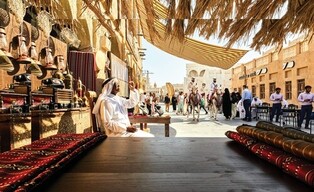






![[가요소식] 보이넥스트도어, 신보로 3연속 밀리언셀러 달성](/news/data/20251025/yna1065624915905018_166_h2.jpg)








